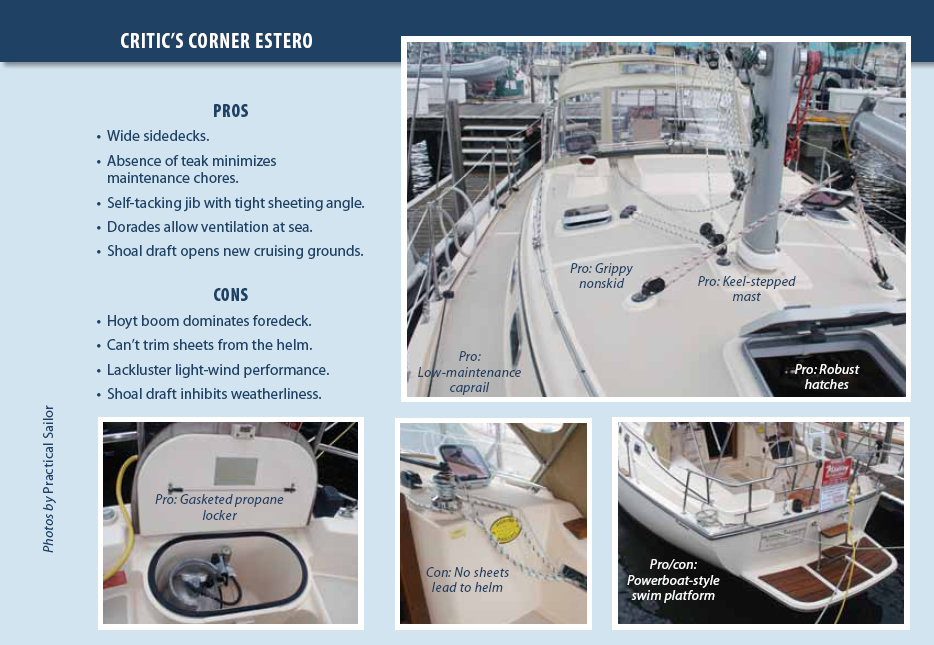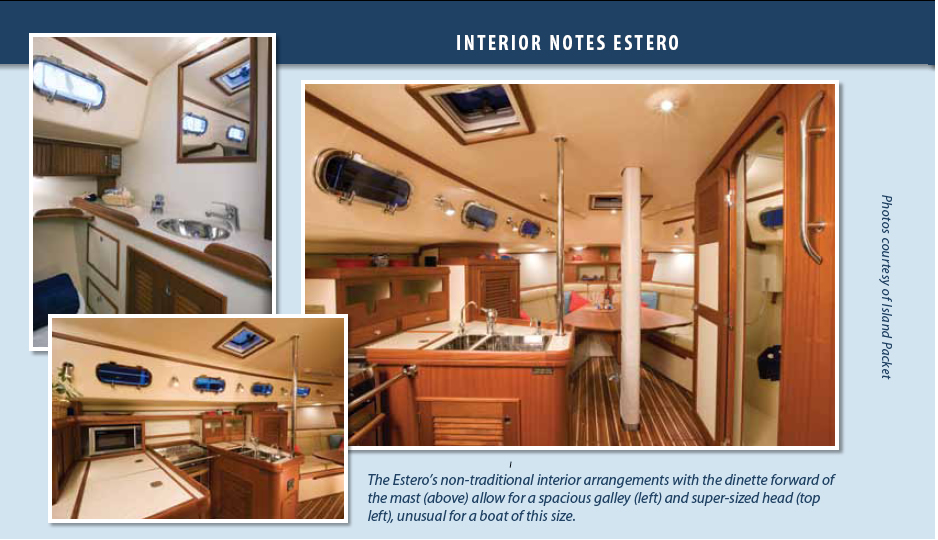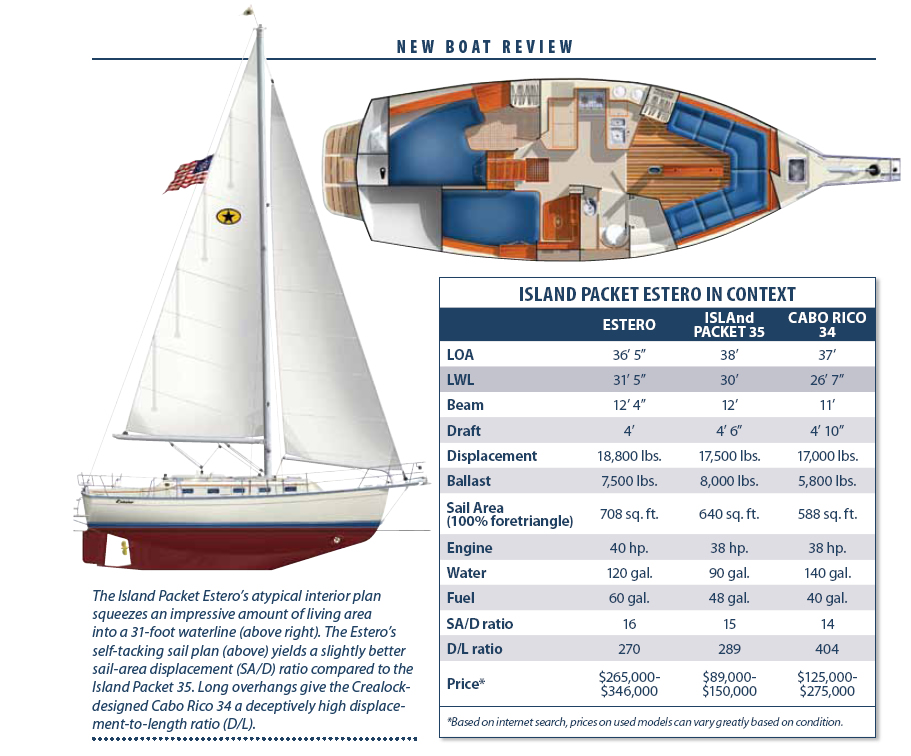
Photos by Billy Black
380
Florida-based Island Packet targets a relatively narrow niche, so the toughest competitors to its new boats are often older Island Packets. Introduced in 2010, the 36-foot shoal draft Estero is the company’s latest attempt to introduce a distinctive model that doesn’t stray too far from the company’s proven formula for success: moderate displacement, full-keel cruisers designed to be lived on, sailed far and in comfort, and endure the bumps, scrapes, and storms that cruising boats inevitably encounter.
Like every new Island Packet, the Estero emerged from the drawing board of founder, owner, CEO and chief designer Robert “Bob” Johnson. A graduate of Massachusetts Institute of Technology with a masters in naval architecture and marine engineering, Johnson worked for McDonell Douglas for two years on ballistic missiles, dabbled in high-tech (for that era) surfboards, then followed his boat dreams to southwest Florida in 1974. He ran the Irwin Yachts plant for production-boatbuilding pioneer Ted Irwin, and then moved onto Endeavour. Johnson designs from that era include the Stamas 44, Endeavour 43, and the Endeavour 40.
Opportunity knocked in 1979, when Johnson turned the liquidated molds for the 26-foot Bombay Express into the Island Packet 26, a catboat-like center-boarder that quickly found a niche. The IP 26 eventually became the full-keel IP 27, which enjoyed a run of 249 hulls between 1984 and 1992. Island Packet has unveiled 24 new Johnson designs during the past three decades. With a few exceptions—the Packet Cat catamaran, the Packet Express powerboat, and the recently introduced 42-foot motorsailer, the SP Cruiser—the line is dominated by full-keel auxiliary sailboats sharing the same basic traits: a U-shaped hull, Johnson’s patented “full-foil” keel, conservative ballast displacement ratio, low aspect rig, and roomy interiors with an emphasis on cruising. Details oriented toward longer-term cruising such as storage space and tankage are an Island Packet strong point.
Currently, Island Packet produces seven boats, ranging from the Estero to the 48-foot flagship, the IP 485. The company’s cult-like following, worldwide dealer network, and the popularity of the SP Cruiser have helped keep the factory operating four days a week through the recent downturn.
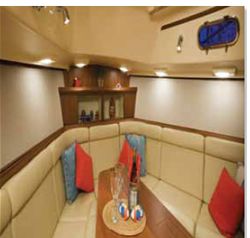
courtesy of Island Packet
250
Design
In many ways, the Estero represents a return to Island Packet’s roots. The shoal draft and flat stern bring to mind boats like the Island Packet 31 (launched in 1983), which had a flat transom and appealed to gunkholers with a centerboard version. All of Island Packet’s mid-range cruisers have a relatively shallow draft, but the Estero’s four-foot draft opens up Carolina backwaters and Florida canals where other Island Packet owners will have to play the tides.
Apart from the keel-haircut, the hull profile is otherwise consistent with Johnson’s previous designs. Johnson is tall, so all of his boats carry plenty of headroom. The high freeboard and lack of any long windows to interrupt the expanse of buff-colored gelcoat make the deckhouse appear higher than it is, but the bowsprit, opening ports, and spring in the shear-line present the intended overall look of a classic, salty cruiser.
One traditional element missing from the Estero found on previous Island Packet designs is the traditional teak caprail—a signature feature for more than 30 years. This offers welcome relief from annual maintenance, although some old salts will no doubt miss the aesthetic appeal.
The boat’s length-to-beam ratio of 2.95 is also in keeping with Johnson’s previous designs, as is the conservative ballast displacement ratio of 40 percent. Comfort in a seaway—like seaworthiness itself—is difficult to quantify, but the boat’s motion-comfort ratio (a calculation introduced by designer Ted Brewer) of 31 puts it not far below that of the Island Packet 370, which has a longer waterline and an additional 5,000 pounds of displacement.
Johnson, who represented the National Marine Manufacturers Association on the Conformité Européenne (CE) committee that helped establish the ratings categories for sailboats (Category A for Ocean, Category B for Offshore, etc.), is keenly aware of the importance of stability, scan’tlings, and resistance to down-flooding in a boat that is to be sailed on oceans. His boats’ solid fiberglass laminate schedule, high freeboard, and conservative ballast-displacement ratios reflect his philosophy on these matters. All Island Packet yachts meet CE Category Standard A for Ocean, “designed for extended voyages where conditions may exceed wind force 8 (Beaufort scale) and significant wave heights of 4 meters and above but excluding abnormal conditions, and vessels largely self-sufficient.” Although PS does not regard the CE Category A to be an automatic stamp of approval of ocean voyaging, we do believe that Island Packets more closely approach our ideal of a cruising boat than some other boats that bear the same rating.
BelowDecks
In the endless quest to turn a 36-foot boat into a comfortable second home, and still provide secure and comfortable berths while the boat is underway, the Estero takes a most radical step by placing the main social area forward of the mast. (The new IP 360 features the conventional V-berth/main saloon layout on the same hull.)
Boats with forward main saloons are by no means original, but they remain very rare birds. Perhaps the most familiar contemporary cruisers with this feature are those of the Gozzard line, which dedicate the space forward of the mast to a spacious sitting/dining area that easily converts to a queen-size berth. In the Gozzard version, the berth conversion can be a semi-permanent setup, because even the smallest Gozzard 37 has an alternate dining nook near the galley.
The Estero’s forward saloon is principally a social/dining area. With the drop-leaf table down, there’s comfortable seating for two couples. With the dining table up it could seat a family of four, and squeeze in a couple of guests, as needed. The table pivots, making it easy to slide in and out of the seats. Throw down sheets and pillows, and the two settees make comfortable berths.
Conversion to the larger berth is more complicated than it should be, considering the premium, well-ventilated sleeping space the saloon occupies. It requires two people (one on their hands and knees fiddling with a troublesome support pole) and optional filler cushions. And once it is set up for sleeping, there is no place to dine belowdecks. With room for four (friendly, we presume) adults and a passel of kids, it is the proverbial feather bed, but the conversion could be easier.
Just aft of the mast and to port is the U-shaped galley. The galley placement is probably the biggest advantage of this layout compared with other boats in this size. Instead of being tucked into an aft corner or in the line of traffic, the galley is set near the fore-and-aft center of the boat, with a hatch overhead and opening portlights for ventilation and a view. The galley covers all the essentials such as counter space, cupboards, and deep well-insulated fridge-freezer systems, but we were disappointed in the shallow, 6-inch-deep sinks—unusual for Island Packet.
Johnson stands 6-feet, 3-inches tall, so his interior designs are sensitive to a tall person’s needs. Just opposite the galley is a super-sized head featuring a bench seat in the separate shower stall.
The owner’s stateroom, located aft and to port, has 6-foot, 4-inches standing headroom, with a cutout in the berth for sitting or getting dressed. A hanging locker, bureau, and full-length mirror add homey touches. A 9-inch overhead hatch and opening portlight offer ventilation, although the hatch won’t allow much breeze if the boat is fitted with a dodger. Our test boat was fitted with a single, full-sized inner spring mattress. We would ask for a folding or two-piece mattress here to simplify access to the storage below, as well as access to the stern gland and stuffing box.
Opposite the owner’s cabin is the nav station with a fold-down chart table and a roomy pilot berth. This area could also be used for storage of larger items like sails, cushions, or guitars.
On Deck
For the past 30 years, the standard Island Packet sail plan has been a cutter rig, featuring a high-cut foresail and a furling working staysail that sets on a Hoyt boom. While a deck-sweeping, club-footed staysail gobbles up foredeck space and leaves remarkable shin bruises, Island Packet owners praise the arrangement for balancing the helm and running wing-and-wing. The Hoyt boom has the added advantage of being self-vanging, keeping the leach clew from lifting as the sheet is eased.
The Estero breaks away from the cutter tradition (although its sistership, the soon-to-debut IP 360 brings it back). The Estero’s working staysail is eliminated, and a foresail sets from a Hoyt boom fixed just forward of the stem on the bowsprit. In this way, both the jib and the main are self-tacking, so working to windward is as easy as turning the wheel. The arrangement also allows for tight sheeting angles.
Although conventional mainsails with lazy jacks were the standard on earlier Island Packets, the company has seen a clear trend toward in-mast furling. According to Bill Bolin, vice president of sales and marketing at Island Packet, the company has sold few, if any, boats with conventional full-battened mainsails in the past eight years. PS generally prefers conventional mainsails for voyaging in boats this size, but if you plan to do a lot of short coastal hops, the in-mast Sparcraft mainsail furler can make life easier, allowing you to set, reef, and furl both sails from the cockpit.
The mainsail and jib halyards are led to dedicated Lewmar Ocean Series 16C two-speed winches on the mast; this reduces clutter at the cabin and makes sense for cruising boats with a furling mainsail. The mainsail roller-furling control line, jib sheet, and spare mainsail halyard lead aft through stoppers to the Ocean Series 30CT two-speed self-tailing winch on the portside of the companionway. The mainsheet and boom-vang lead through a stopper and matching winch on the starboard side of the companionway.
Those accustomed to contemporary sloops will be surprised to find that the only sail control line within easy grasp of the helmsman is the jib furling line, which is on 16CT Lewmar on the starboard coaming. Because the mainsail and jib set on self-tacking booms, the arrangement is not as inconvenient it would seem. Leading the mainsail traveler lines (fixed in cam cleats) aft allows limited sail control from the helm. A port coaming winch will be missed when you want to kedge off a shoal, or when trying to warp the stern to port.
The 7-foot-long cockpit seats offer plenty of room to stretch out. A large starboard locker offers room enough for two folding bikes and more; a port tray keep small items accessible. Liner bins in the coamings keep the deck clear of running rigging. The emergency tiller has a dedicated spot in the starboard locker.
Visibility is excellent, and the twin 2-inch cockpit drains and high bridgedeck deal with any boarding waves. Drop boards are solid hardwood. Comfortable platform seats are integrated into the stern rail.
The boat we test-sailed had an optional stern swim platform. By eliminating the sugar-scoop transom/swim platform on other Island Packets, the Estero benefits from more usable interior space, a larger cockpit, and more cockpit storage space. A boarding ladder is accessible from the water for emergency reboarding. One drawback to this design is the inevitable “slap” that will accompany pitching at anchor. According to Johnson, the platform is elevated high enough (24-inches above displacement waterline) so that slapping at anchor or added drag underway is unlikely.
“This is an immensely strong installation typical of our approach to all structural components on an IP,” Johnson said. “(It) has been validated over a number of years . . . by other IPs that have this identical installation.”
A high coaming and wide passage forward leads to the foredeck where a deep locker with an aft-opening Lewmar hatch seals a deep anchor well. The divided well swallows up chain and fenders and drains into the bilge through a watertight bulkhead that seals the locker off from the rest of the boat. An optional VRC 1250 Muir windlass, single bow roller, and chain stopper handled anchoring duties on our boat.
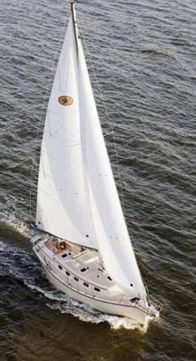
except where noted.
196
Systems
Johnson brings his engineering expertise to bear on the Estero’s mechanical systems. The conventional drive train is the most sensible choice for long-term cruising. The solid Edson CD-I geared rack-and-pinion steering is well adapted to belowdecks autopilot. The propeller and rudder skeg are protected by a long “shoe” extending from the keel to the skeg.
Twin lead-acid house batteries and a dedicated engine battery serve electrical storage needs. Pre-tinned, labeled wiring meets American Boat and Yacht Council (ABYC) standards. A Charles 5000 series three-stage temperature-compensated charger with a galvanic isolator protect the electrical system and ensure it is well charged at the dock.
The 60-gallon fuel tank is made of heavy-gauge, marine-grade aluminum (5052-H32), while the freshwater (120 gallon) and holding tanks (35 gallon) are located below the cabin sole and made of fiberglass. All through-hulls are bronze and through bolted to flanged seacocks.
Cables for the anchor windlass and bow thruster are pre-wired. The LPG system meets ABYC standards with a self-draining locker and shut-off valve in the galley. LED lighting is an option. The bow thruster, located under the main-saloon settee, had tighter all-around clearances than installations we’ve seen on other boats with big V-berths.
Performance
By contemporary fin-keel standards, the sailing performance of the Estero is unimpressive, but Island Packet owners aren’t the kind that go looking for the extra 5 percent of hull speed and the Estero isn’t meant to be a Wednesday-night racer.
Our test boat was provided by Ed Massey of Massey Yacht Sales and Services, and the test sail took place within sight of Massey’s Bradenton dealership on the Bradenton River, Fla., in squally weather, with light gusty winds from the east between 8 to 12 knots, with gusts to 14 knots.
At 2,400 rpm, the Yanmar 40-horsepower engine with a big 17-inch, three-bladed prop pushed the boat at 6.6 knots. At wide-open throttle, 3,400 rpm, the average speed was 7.3 knots. The higher RPM is clearly not an efficient motoring speed, but testing it confirmed that reserve horsepower is available if needed. Unlike flat-bottomed fin-keel boats, the Estero’s hull speed is tightly constrained by its waterline length. At the lower cruising speed, we registered 79 decibels in the center of the main saloon and a quiet 74 decibels in the cockpit with the companionway open. Vibration at the higher RPM raised the main saloon volume to 83 decibels. (Conversation is about 60-70 decibels.)
Under power, the Estero embodies the typical tradeoffs of a full keel. The full keel’s tracking ability—so helpful on long passages—becomes a handicap in close-quarter maneuvering. The lateral resistance lengthens turning radii, and when backing, the boat has a stronger tendency to “walk” in the direction of the prop rotation. Our test boat was equipped with a $6,000 Vetus bow thruster that took the drama out of docking and maneuvering at slow speeds. A good skipper will soon become accustomed to the Estero’s idiosyncrasies under power and learn to use prop-wash and spring lines to his advantage, but full-keel novices will appreciate the bow thruster.
Like her cutter-rigged cousins in the Island Packet line, the Estero is happiest on a reach. Broad reaching with the apparent wind at 135 degrees, the boat balanced well, but averaged only 4 knots speed over ground in about 9 knots of apparent wind—suggesting an asymmetrical spinnaker would be a wise addition in light-wind areas. On a beam reach in 9 knots apparent, average speeds were about 5.5 knots. The best sustained speed during our test was 6.3 knots, with the apparent wind at about 10 knots and 110 degrees.
Any shoal-draft boat must sacrifice windward performance, and the Estero is no exception. The Estero’s tight sheeting angles and foil-shaped full keel help add lift, but the windward performance is still held back by the increased skin drag and low-aspect keel.
The course made good on our test sail fell below fin-keeler standards, but it was comparable to that of similar boats we have sailed. The best sustained speed close reaching was 5.7 knots, and the boat tacked through 100 degrees, including leeway. (For a stark comparison, the lightweight J/95 daysailer, drawing 3 feet with its board retracted, tacked through 92 degrees in similar conditions.)
The Estero doesn’t like to be pinched, and it will quickly let you know when the main is over-trimmed with an insistent weather helm. Like many full-keelers with low-aspect rudders, too much helm will stall the boat. It responds slowly but positively to the helm, and it is slow to pick up speed. We would not characterize the Estero as exciting in light winds, but in breezier areas, the boat’s ability to keep her feet and to shoulder aside chop will be appreciated.
Conclusion
The Estero will appeal strongest to Island Packet fans who’ve been waiting for a shoal-draft, easy-to-sail boat that compares to the IP37 in terms of interior space. These strengths will be most apparent on intracoastal or riverine adventures like the Great Loop.
The novel changes aren’t suited for everyone. Those who cruise warm climates in summer, for example, will miss the large overhead hatch of a V-berth. The self-tending headsail will please sailors who prefer a relaxing bay sail or motor-sail to winch-grinding and close-hauled excitement.
The list price of $350,000 seems steep when you see IP37s going for less than half that, but Island Packet offers a generous 10-year warranty on both the hull and deck, and a three-year stem-to-stern warranty. Past owners have done fairly well sailing their boat for a couple of years and then trading up or selling for close to purchasing price, while the boat is still covered under warranty.
For those who like the shoal-draft concept but would prefer a conventional layout, the cutter-rigged IP360, with 130 square feet of additional sail area, fits the bill. While we see a niche for the Estero, we expect the IP360 will be a more popular design.
